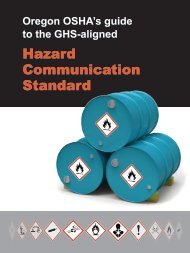Technical Manual - Section 3 (Safety Hazards)
Technical Manual - Section 3 (Safety Hazards)
Technical Manual - Section 3 (Safety Hazards)
You also want an ePaper? Increase the reach of your titles
YUMPU automatically turns print PDFs into web optimized ePapers that Google loves.
Figure III-2:15 Two-Stage Hydrocracking<br />
needed to ensure that explosive concentrations of catalytic<br />
dust do not form during recharging.<br />
<strong>Safety</strong><br />
Inspection and testing of safety relief devices are important<br />
due to the very high pressures in this unit. Proper process<br />
control is needed to protect against plugging reactor beds.<br />
Unloading coked catalyst requires special precautions to<br />
prevent iron sulfide-induced fires. The coked catalyst should<br />
either be cooled to below 120º F before dumping, or be<br />
placed in nitrogen-inerted containers until cooled.<br />
Because of the operating temperatures and presence of<br />
hydrogen, the hydrogen-sulfide content of the feedstock must<br />
be strictly controlled to a minimum to reduce the possibility<br />
of severe corrosion. Corrosion by wet carbon dioxide in areas<br />
of condensation also must be considered. When processing<br />
high-nitrogen feedstocks, the ammonia and hydrogen sulfide<br />
form ammonium hydrosulfide, which causes serious<br />
corrosion at temperatures below the water dew point.<br />
Ammonium hydrosulfide is also present in sour water<br />
stripping.<br />
Health<br />
Because this is a closed process, exposures are expected to be<br />
minimal under normal operating conditions. There is a<br />
potential for exposure to hydrocarbon gas and vapor<br />
emissions, hydrogen and hydrogen sulfide gas due to<br />
high-pressure leaks. Large quantities of carbon monoxide<br />
may be released during catalyst<br />
III:2-30
















